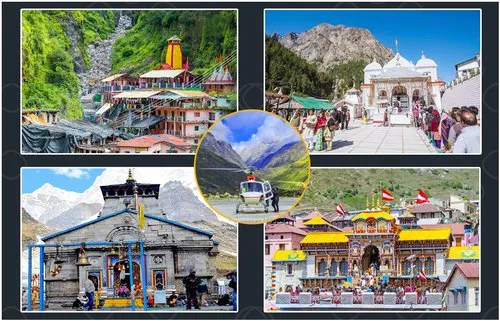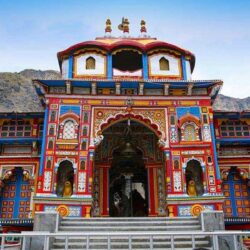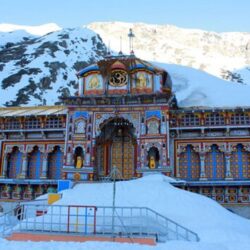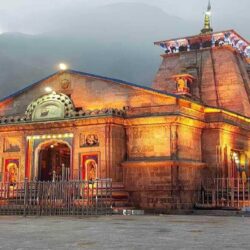Description
OverView
Chardham Yatra from Pune: A Spiritual Journey of a Lifetime
Embarking on the Chardham Yatra is a cherished aspiration for countless devotees, offering a spiritual retreat amidst the serene Himalayas. For those in Pune, the journey to these four sacred shrines – Yamunotri, Gangotri, Kedarnath, and Badrinath – has been made accessible with well-organized travel packages and options to suit every pilgrim’s need. Here’s everything you need to know about planning your Chardham Yatra from Pune.
Best Time to Visit
The Chardham Yatra is open from late April/May to October/November, depending on weather conditions. The ideal time to undertake the yatra is between May and June or September and October, avoiding the monsoon season when landslides and roadblocks are common.
Travel Packages for Chardham Yatra from Pune
Many travel operators offer comprehensive packages from Pune, covering transportation, accommodation, meals, and guided tours. Some popular options include:
- Helicopter Packages: Ideal for senior citizens or those with limited time, these packages provide helicopter services to and from the shrines.
- Economy Packages: Budget-friendly tours with basic amenities and group travel options.
- Luxury Packages: Premium accommodations, personalized services, and private vehicles for a comfortable journey.
Chardham Yatra from Pune |
|
|---|---|
| Tour Name: | Chardham Yatra from Pune |
| Tour Duration: | 09Nights / 10days |
| Destinations Covered: | Pune- Delhi- Haridwar – Barkot- Yamunotri -Uttarkashi -Gangotri -Guptkashi -Kedarnath- Badrinath- Joshimath – Rudraprayag. |
| Tour Price: | 25,500/- Per Person+5%GST(Min- 6 Person) |
Itinerary
Day 01:Pune – Delhi
This Day Catch Flight from airport, ahmedabad for Onward Journey to Delhi! you will be met by an ITT representative On arrival at New Delhi Airport.Board the Coach and drive to Haridwar.
Day 02: Haridwar – Barkot
Welcome to Chardham yatra. Arrival from railway station assist by ITT executive and Drive to Barkot via Dehradun & Mussoorie. Enroute visit Kempty Fall and others later drive straight to your Hotel for night halt.
Day 03: Barkot – Yamunotri – Barkot
Drive to Hanuman Chatti, for Janki chatti (It helps to reduce the trek upto 8 kms), trek start from here to Yamunotri (6kms). Either by walk or by horse or by Doli at own cost. Arr. Yamunotri, One can cook rice by packing it in a cloth and dipping it in the hot water of the hot kund. Pilgrims take this cooked rice home as “Prasad”. Here near the temple “Pooja” can be offered to Divya Shila, after taking bath in Jamunabai Kund’s warn water and having “Darshan” of pious “Yamunaji” returning to Hanumanchatti. Later drive back to Barkot. Overnight stay at Hotel.
Hanuman Chatti: The confluence of Hanuman Ganga & Yamuna River.
Yamunotri Temple: Maharani Gularia of Jaipur built the temple in the 19th Century. It was destroyed twice in the present century and rebuilt again.
Surya Kund: There are a Number of thermal springs in the vicinity of the temple, which flows into numerous pools. The most important of these is Surya Kund.
Divya Shila: A rock pillar, worshipped before entering the Yamunotri Temple.
Day 04: Barkot – Uttarkashi
Drive to Uttarkashi on arrival Check in the Hotel, Later visit Vishwanath Temple .Night Halt.
Uttarkashi: Situated at the bank of river Bhagirathi. The temple of Lord Vishwanath is located here where a massive iron trident is erected. The other important temples situated here are Annapurna Devi Temple, Ekadash Rudra, Bhairav, Gyaneshwar and Goddess Kuteti Devi.
Day 05: Uttarkashi – Gangotri – Uttarkashi
We proceed to Gangotri (3048 mts), enroute we enjoy picturesque Harsil village, Bhagirathi River and the most magnificent view of the Himalayas . After Gangotri Darshan we return to Uttarkashi. Overnight stay at Uttarkashi.
Gangotri Temple: The temple, constructed by the Gorkha General Amar Singh Thapa in the 18th Century, is situated on the right bank of Bhagirathi.
Submerged Shivling: Submerged in the river, this natural rock Shivling is the place where, according to mythology Lord Shiva sat when he received the Ganga in his matted lock. It is visible in winter months when water level decreases.
Kedar Ganga Sangam: Around 100 Yards from the Ganga Temple flows the river Kedar Ganga. Starting from the Kedar Valley, this river meets the Bhagirathi on its left bank.
Day 06:Uttarkashi- Guptkashi
Early morning, drive to Guptkashi .On Arrival Check in Hotel, night halt.
Day 07: Guptkashi – Kedarnath- Guptkashi
Morning drive to Sonprayag, Trek start from Sonprayag to Kedarnath (3584 mts) on foot or on by pony / Doli. Tour members should carry personal medicines, heavy woolen, tolietteries and clothes for an overnight halt at Kedarnath. Check in Hotel. Later visit Kedarnath Temple. Later back to Guptakashi. Night halt.
Gaurikund: At a distance of 5kms from Sonprayag and at an altitude of 1982 meters, one can take bath in the hot water pond here and visit the Gauri Temple. This is the place where Goddess Parvathi meditated to attain Lord Shiva. It is the base for a trek to Kedarnath.
Kedarnath: The Kedarnath shrine, one of the 12 jyotirlingas of Lord Shiva, is a scenic spot situated, against the backdrop of the majestic Kedarnath range. Kedar is another name of Lord Shiva, the protector and the destroyer. According to legend, the Pandavas after having won over the Kaurava in the Kurukshetra war, felt guilty of having killed their own brothers and sought the blessings of Lord Shiva for redemption. He eluded them repeatedly and while fleeing took refuge at Kedarnath in the form of a bull. On being followed he dived into the ground, leaving his hump on the surface. The remaining portions of Lord Shiva appeared at four other places and are worshipped there as his manifestations. The arms appeared at Tungnath, the face at Rudranath, the belly at Madhmaheshwar and his locks (hair) with head at Kalpeshwar. Kedarnath and the four above-mentioned shrines are treated as Panch Kedar.
Day 08: Guptkashi – Badrinath
Drive to Badrinath via Joshimath. Check in Hotel. Later at evening visit Badrinath Temple for Aarti. Overnight stay.
Badrinath one of the ‘Four Dhams’ is one of the most celebrated pilgrimage spots of the country and is situated at an elevation of 3,133 meters, guarded on either side by the two mountain ranges known as Nar & Narayan with the towering Neelkanth Peak providing a splendid backdrop. This revered spot was once carpeted with wild berries. Thus the place got the name “Badri van”, meaning “forest of berries”.
Tapt Kund : Natural thermal springs on the bank of the river Alaknanda, where it is customary to bathe before entering the Badrinath temple.
Narad Kund : A recess in the river, near Tapt Kund, forming a pool from where the Badrinath idol was recovered.
Brahama Kapal : A flat platform on the bank of river Alaknanda. Hindus perform proppitiating rites for their deceased ancestors.
Sheshnetra : 1.5kms. away is a boulder having an impression of the legendary serpent, better known as the Sheshnag’s eye.
Charanpaduka : 3kms. away is a beautiful meadow where the footprint of Lord Vishnu is seen on a boulder.
Mata Murty Temple : Devoted to the mother of Sri Badrinathji. Other important temples include Sesh Netra Temple , Urvashi Temple and Charanpaduka.
Mana Village : Inhabited by an Indo-Mongolian tribe, it is the last Indian village before Tibet .
Vasundhara : As the name suggests, vasundhara is a magnificent water fall. This place is 5 kms. from Badrinath out of which 2 kms. is motorable upto Mana.
Bhim Pul : On the other side of Mana village, a massive rock forming a natural bridge, lies over the roaring Saraswati river. It presents a spectacular view of water thundering down through the narrow passage under the rock and is believed to have been placed there by Bhim, the second eldest among the five Pandava brothers.
Vyas Gufa (cave) : Near Mana Village, this is a rock-cave where Ved Vyas is believed to have composed the Mahabharata and the pauranic commentaries.
Day 09: Badrinath – Joshimath – Rudraprayag
Early morning, pilgrims after having a bath in the Taptkund have the Darshan of Badrivishal. Brahamakamal is significant for Pinddan Shraddh of ancestors (Pitrus). There are other interesting sightseeing spot like Mana, Vyas Gufa, Maatamoorti, Charanpaduka, Bhimkund and the “Mukh” of the Saraswati River . Just within the three kms of Badrinathjee. Later drive back to Rudraprayag via Joshimath. Check in Hotel.
Joshimath is situated on the slopes above the confluence of Alaknanda and Dhauliganga. Of the four ‘Maths’ established by Adi Shankaracharya, Joshimath is in the Badrinath to Joshimath and installed in the temple for people to worship. There are many temples in the township most important is the temple of Nir Singh in commotion of Lord Vishnu. The left arm of this deity is with time and the popular belief holds that the day the the arm completely withers Badrinath valley will cease to exist and the Gods will transfer the residence into the neighboring Niti Valley at Bhavishya Badri. Joshimath is connected by regular bus service to Rishikesh, Haridwar, Badrinath and many other centres in the region.
Day 10: Rudraprayag – Rishikesh- Delhi
Drive back to Delhi. On Arr. Delhi, transfer to Railway Station / Airport time to catch your Train/Flight for ahmedabad .
Price
Call for Best Deal: +91 9870240354
Hotels Details:
Call for Best Deal: +91 9870240354
Inclusions
- Pick up and drop from airport/railway/bus station.
- Accommodation on double/twin sharing basis.
- All breakfast included at hotels.
- All transfers and sightseeing by private A/C vehicle.
- Driver’s bata, toll, parking, road tax, fuel charges All applicable taxes.
Exclusion
- Service Tax – 5% GST Extra.
- Any air/bus/rail fare Any other meals not mentioned in package inclusions.
- Any other destination not mentioned in itinerary.
- Any personal expenses such as laundry, room service, mini bar, telephone etc.
- Guide charges/boating charges/entrance fees for any sightseeing
- Any services or activity charges other than those included in inclusions.
- Supplementary cost for festival period, long weekend or peak season .






